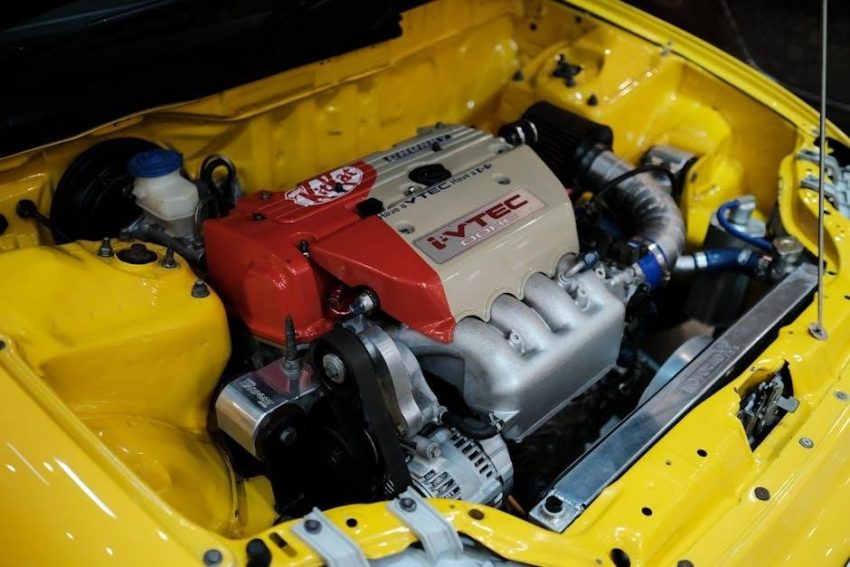The 2017 Honda CR-V Maintenance Schedule PDF is a comprehensive guide for owners, outlining essential tasks and intervals to maintain optimal performance and reliability. It helps prevent issues and extend the vehicle’s lifespan. The PDF is available for download from Honda’s official website for easy access to necessary service details;
1.1 Overview of the Importance of Regular Maintenance
Regular maintenance is crucial for ensuring the 2017 Honda CR-V operates efficiently and safely. It prevents mechanical issues, enhances performance, and prolongs the vehicle’s lifespan. By following the recommended schedule, owners can avoid costly repairs and maintain reliability. Scheduled tasks like oil changes and tire rotations are essential for optimal functionality. Proper upkeep also ensures safety on the road, as worn or damaged components can lead to accidents. Additionally, regular maintenance helps maintain the vehicle’s warranty and resale value. Owners should prioritize these routine checks to keep their CR-V in peak condition and address potential problems before they escalate.
1.2 How to Locate the Official 2017 Honda CR-V Maintenance Schedule PDF
The official 2017 Honda CR-V Maintenance Schedule PDF can be easily accessed through the Honda Owners website. Owners can visit the site, log in to their account, and navigate to the “Maintenance” or “Support” section. Additionally, the PDF may be available for download directly from Honda’s official portal. Alternatively, authorized Honda dealerships can provide a copy upon request. For convenience, some forums and automotive websites also host the document, but it’s essential to verify its authenticity to ensure accuracy. Always refer to the official Honda source to avoid outdated or incorrect information.
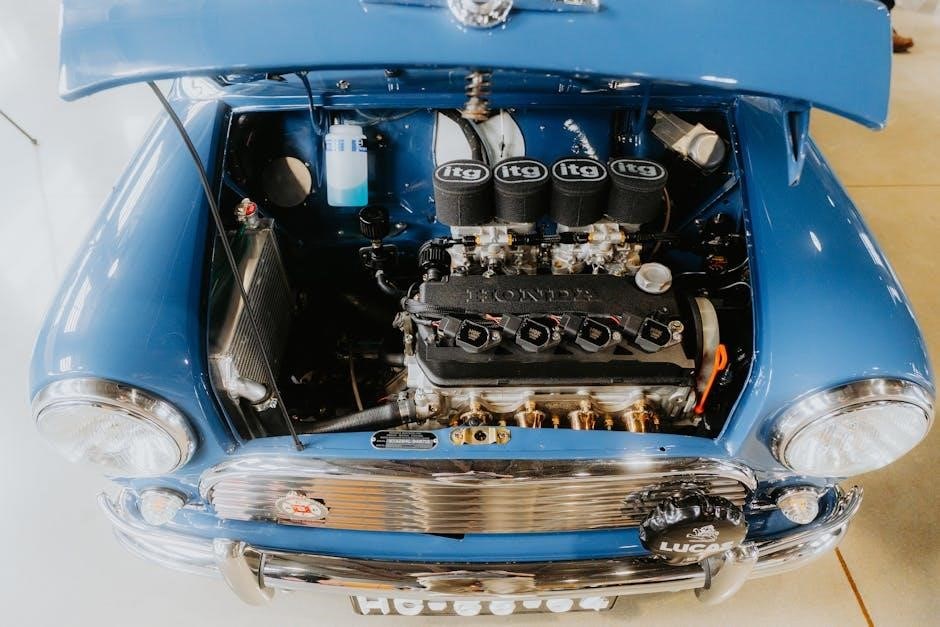
Key Maintenance Tasks for the 2017 Honda CR-V
Regular oil and filter changes, tire rotations, and brake fluid replacements are essential; Inspections of tire treads, brake components, and fluid levels ensure optimal vehicle performance and safety.
2.1 Oil and Filter Changes
Regular oil and filter changes are crucial for the 2017 Honda CR-V to ensure engine longevity and performance. Honda recommends using 0W-20 synthetic oil for optimal lubrication. The oil and filter should be replaced every 5,000 to 7,500 miles, depending on driving conditions. The Maintenance Minder system will alert you when service is due, using codes like “A” for oil changes. Always use genuine Honda oil filters to maintain quality and prevent engine damage. Neglecting this maintenance can lead to increased wear, reduced fuel efficiency, and potential engine damage. Refer to the PDF schedule for precise intervals and guidelines to keep your CR-V running smoothly.
2.2 Tire Rotations and Pressure Checks
Regular tire rotations and pressure checks are vital for maintaining the 2017 Honda CR-V’s safety, fuel efficiency, and tire longevity. The recommended tire rotation interval is every 5,000 to 7,500 miles, ensuring even tread wear and preventing uneven patterns. Proper tire pressure, as specified in the owner’s manual or on the tire information placard, should be checked monthly and before long trips. Underinflated tires can lead to reduced handling, increased wear, and lower fuel efficiency. Overinflated tires may compromise traction and ride comfort. Using the correct rotation pattern and maintaining accurate pressure levels helps preserve tire health and enhances overall vehicle performance. Always refer to the maintenance schedule PDF for detailed guidelines on tire care.
2.3 Brake Fluid Replacement
Brake fluid replacement is essential for ensuring the 2017 Honda CR-V’s braking system functions safely and efficiently. The maintenance schedule recommends replacing the brake fluid every 30,000 to 60,000 miles to prevent corrosion and maintain hydraulic performance. Using genuine Honda Brake Fluid DOT 3 or DOT 4 is strongly advised, as non-Honda fluids may cause system damage. Regular inspections of the brake fluid level and condition are also crucial. Low fluid levels or contamination can lead to reduced braking performance, posing safety risks. Always refer to the official maintenance schedule PDF for specific guidelines and intervals to keep your CR-V’s brakes reliable and responsive. Proper brake fluid maintenance is vital for protecting your vehicle’s longevity and ensuring safe driving conditions.
2.4 Inspection of Tire Treads and Brake Components
Regular inspection of tire treads and brake components is critical for ensuring the 2017 Honda CR-V’s safety and performance. Tire treads should be checked for wear, uneven patterns, and proper depth to maintain traction and handling. Brake components, including pads, rotors, and calipers, must be inspected for wear or damage to ensure reliable stopping power. The maintenance schedule recommends these inspections at specific intervals, such as during tire rotations or brake fluid replacements. Addressing issues early prevents costly repairs and enhances safety. Always refer to the official PDF for detailed guidelines on how to perform these checks and when they are required. Proper maintenance of these systems is essential for protecting your vehicle and ensuring optimal performance on the road.
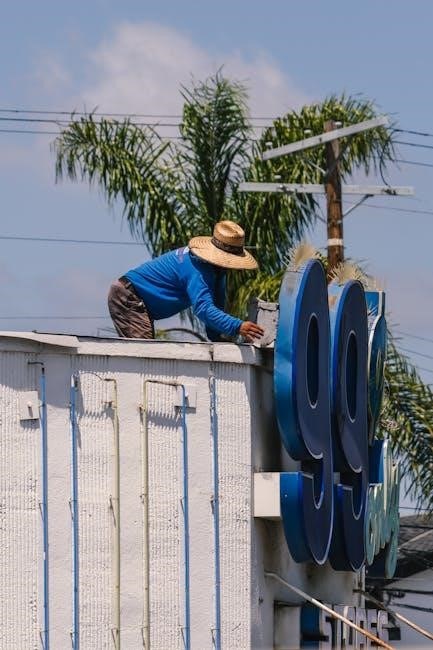
Mileage-Based Maintenance Intervals
The 2017 Honda CR-V maintenance schedule outlines specific service requirements at various mileage checkpoints, ensuring timely care and preventing potential issues. Regular intervals help maintain reliability and performance.
3.1 Maintenance Requirements at 5,000 to 7,500 Miles
At 5,000 to 7,500 miles, the 2017 Honda CR-V requires routine maintenance to ensure optimal performance. This includes oil and filter changes, tire pressure checks, and tire rotations. Additionally, the vehicle’s fluids, such as brake and transmission fluids, should be inspected and topped off if necessary. The CR-V’s Maintenance Minder system will typically indicate these needs with specific codes. It’s also a good idea to inspect the air filter and wiper blades for wear. Following these steps helps maintain the vehicle’s reliability and prevents more costly repairs down the road. Proper maintenance at this interval is crucial for sustaining the CR-V’s fuel efficiency and overall performance.
3.2 Scheduled Services at 15,000 Miles
At 15,000 miles, the 2017 Honda CR-V requires more detailed maintenance to ensure long-term reliability. This service includes an oil and filter change, tire rotation, and a comprehensive inspection of belts and hoses. Fluid levels, such as engine oil, transmission, and coolant, should be checked and topped off. Additionally, the air filter and cabin air filter may need replacement. Brake pads and rotors should be inspected for wear, and the battery should be tested for optimal performance. The exhaust system and suspension components are also checked for any signs of damage or wear. Following these steps ensures the CR-V runs smoothly and maintains its performance. Proper maintenance at this interval is essential for preventing unexpected repairs and extending the vehicle’s lifespan.
3.3 Comprehensive Checks at 30,000 Miles
At 30,000 miles, the 2017 Honda CR-V requires a detailed inspection to ensure all systems are functioning optimally. This includes replacing the engine air filter and checking the condition of the spark plugs. The belts and hoses should be inspected for signs of wear or cracking. Brake components, such as pads and rotors, are evaluated for thickness and evenness. Additionally, the suspension system is checked for alignment and stability. Fluid levels, including engine oil, coolant, and transmission fluid, are assessed for proper levels and condition. The battery and charging system are also tested for performance and reliability. Finally, the exhaust system is inspected for leaks or damage, and tire pressure is adjusted as needed. This comprehensive check ensures the CR-V remains in excellent condition and prevents future issues.

The Honda Maintenance Minder System
The Honda Maintenance Minder System is a built-in feature that tracks your vehicle’s maintenance needs using specific codes. It provides reminders for required services based on mileage and conditions, ensuring timely upkeep and optimal performance of your 2017 Honda CR-V.

4.1 Understanding the Maintenance Minder Codes
The Maintenance Minder System uses specific codes to indicate required services for your 2017 Honda CR-V. These codes, displayed on the instrument panel, are designed to notify you when routine maintenance is due, such as oil changes, tire rotations, and brake fluid replacements. Each code corresponds to a particular service, ensuring you stay on track with the recommended maintenance schedule. By understanding these codes, you can address service needs promptly, helping to maintain your vehicle’s performance and longevity. Regular monitoring of these codes ensures that you never miss an essential maintenance task, keeping your CR-V in optimal condition. Always refer to your owner’s manual for detailed explanations of each code and the appropriate actions to take. This system is a convenient and reliable way to manage your vehicle’s upkeep, providing peace of mind and preventing potential issues down the road. Additionally, the codes are generated based on mileage and driving conditions, making them a personalized guide for your CR-V’s specific needs. By following the Maintenance Minder’s instructions, you can ensure that your vehicle receives the care it requires to run smoothly and efficiently for years to come.
4.2 How the System Tracks Service Needs
The Honda Maintenance Minder System tracks service needs by monitoring driving conditions, mileage, and the condition of key components like engine oil and brake fluid. Sensors throughout the vehicle collect data on factors such as oil degradation, tire wear, and brake pad condition. This information is analyzed to determine when maintenance is required. The system alerts the driver through codes displayed on the instrument panel, ensuring timely service. It also takes into account varying driving habits and conditions, providing personalized maintenance recommendations. By continuously monitoring the vehicle’s health, the system helps prevent overdue maintenance, reducing the risk of damage and keeping the CR-V running efficiently. This intelligent approach ensures that service needs are addressed proactively, maintaining performance and reliability over time.
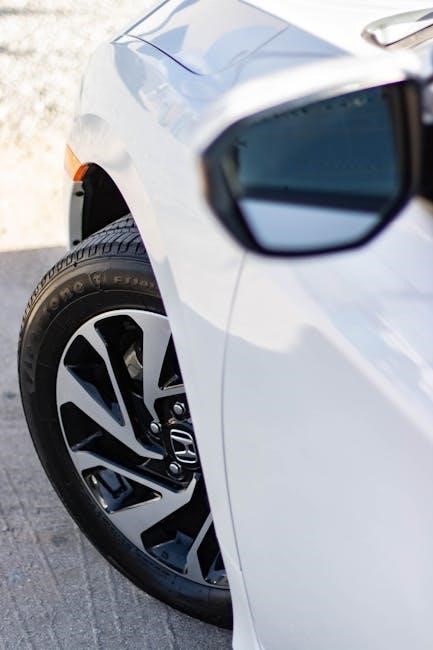
Additional Maintenance Recommendations
Regular fluid checks, battery inspections, and belt replacements are crucial. Ensure the electrical system is functioning properly and inspect hoses for signs of wear. Replace components as recommended.
5.1 Fluid Checks and Replacements
Fluid checks are vital for the 2017 Honda CR-V’s performance. Regularly inspect engine oil, coolant, transmission, and brake fluids. Replace them as recommended to prevent corrosion and maintain efficiency. Use genuine Honda fluids to ensure compatibility and longevity. Check for leaks and top off levels as needed. Adhere to the schedule outlined in the maintenance PDF to avoid overheating and mechanical failures. Proper fluid management ensures smooth operation and extends the lifespan of critical systems. Always refer to the official guide for specific intervals and procedures to maintain your CR-V in optimal condition. This proactive approach safeguards against costly repairs and keeps your vehicle running reliably.
5.2 Inspections of Belts and Hoses
Inspections of belts and hoses are crucial for the 2017 Honda CR-V’s reliability. Check the serpentine belt for cracks, frays, and wear every 15,000 miles. Replace it at 90,000 miles or sooner if damage is found. Hoses, including coolant and radiator hoses, should be examined for leaks, brittleness, and soft spots. Inspect clamps and connections for tightness. Addressing these issues early prevents breakdowns and costly repairs. Follow the maintenance schedule PDF for specific inspection intervals. Regular checks ensure the engine stays cool and performs efficiently. Always use genuine Honda parts for replacements to maintain durability. This routine helps avoid unexpected failures and keeps your CR-V running smoothly for years. Stay proactive with these inspections to uphold your vehicle’s health and performance.
5.3 Battery and Electrical System Checks
Regular battery and electrical system checks are vital for the 2017 Honda CR-V’s performance. Inspect the battery terminals for cleanliness and tightness, ensuring no corrosion or wear. Check the battery’s charge level and age, replacing it every 5 years or when capacity drops below 75%. Verify the alternator’s function and belts for proper charging. Test all electrical components, such as lights, wipers, and accessories, to ensure they operate correctly. Look for frayed wires or connectors that may cause malfunctions. Follow the maintenance schedule PDF for specific intervals. Addressing electrical issues early prevents sudden failures and keeps your CR-V reliable. Proper care extends the lifespan of these critical systems, ensuring your vehicle starts and runs smoothly year-round.

DIY vs. Professional Maintenance
The 2017 Honda CR-V maintenance schedule allows for some DIY tasks, like oil changes and tire checks, while complex repairs require a certified technician for reliability and safety.
6.1 Tasks You Can Perform at Home
Performing DIY maintenance on your 2017 Honda CR-V can save time and money. Simple tasks include oil changes, tire pressure checks, and tire rotations. You can also inspect fluid levels, such as engine oil, coolant, and windshield washer fluid, and top them off as needed. Checking the air filter and replacing it when dirty is another easy task. Additionally, you can visually inspect the battery terminals for corrosion and clean them if necessary. Always use genuine Honda parts to ensure compatibility and reliability. For more complex tasks, consult your owner’s manual or the maintenance schedule PDF for guidance. These DIY efforts help maintain your CR-V’s performance and extend its lifespan. Always follow safety precautions when working under the hood or with tools.
6.2 When to Visit a Certified Honda Technician
While many maintenance tasks can be done at home, certain services require the expertise of a certified Honda technician. These include brake fluid replacement, comprehensive inspections of belts and hoses, and diagnostic checks using the Honda Maintenance Minder system. If your CR-V’s maintenance minder codes indicate a need for professional service, such as transmission fluid changes or spark plug replacements, it’s best to schedule an appointment. Certified technicians have the tools and knowledge to ensure services are performed correctly, using genuine Honda parts. They can also identify potential issues before they become major problems. Avoid using non-Honda parts, as they may void warranties or cause system incompatibilities. Always refer to the maintenance schedule PDF for guidance on when professional service is required to maintain your CR-V’s performance and longevity.

Accessing the Maintenance Schedule PDF
To obtain the 2017 Honda CR-V maintenance schedule PDF, visit the official Honda Owners website or contact a local dealership for assistance. Additionally, check the owner’s manual or use the Honda mobile app for convenient access. Online forums and communities may also provide shared resources, but ensure the source is reliable; If online methods fail, consult a Honda service center or trusted mechanic for guidance.
7.1 Downloading from the Honda Owners Website
To download the 2017 Honda CR-V maintenance schedule PDF, visit the official Honda Owners website. Navigate to the “Owners” section and log in to your Honda account. If you don’t have an account, create one by registering your vehicle using the VIN. Once logged in, search for the 2017 CR-V maintenance schedule in the resources or manuals section. Click on the PDF link to download it directly to your device. Ensure the document is labeled as official to guarantee accuracy. This method provides a reliable and convenient way to access essential maintenance information. Additionally, the website may offer troubleshooting guides or direct links to ensure a smooth experience.

7.2 Alternative Sources for the Schedule
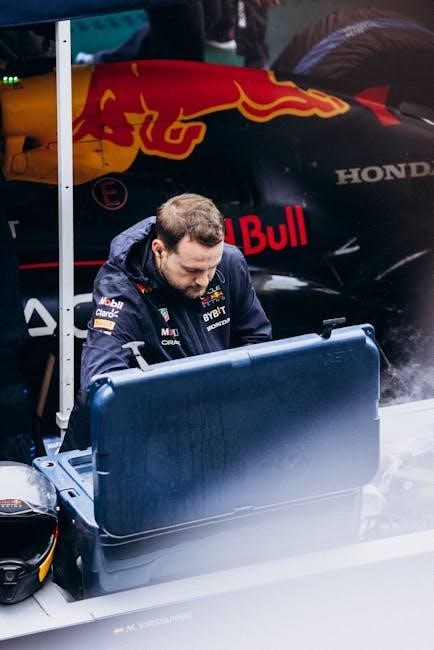
If the official Honda Owners website is inaccessible, alternative sources can provide the 2017 Honda CR-V maintenance schedule PDF. Forums like Honda CR-V communities or vehicle maintenance forums often share downloadable PDFs. Additionally, third-party automotive websites may host the document for public access. Local Honda dealerships can also provide a copy upon request, ensuring authenticity. Lastly, platforms like Google Drive or Yandex Disk may have user-uploaded versions, though verifying authenticity is crucial. Always ensure the source is reliable to avoid outdated or incorrect information. These alternatives offer convenient solutions for accessing the schedule when the official site is not an option.

